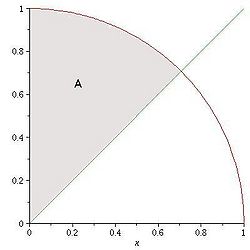Science:Math Exam Resources/Courses/MATH103/April 2012/Question 03 (b)
{{#incat:MER QGQ flag|{{#incat:MER QGH flag|{{#incat:MER QGS flag|}}}}}}
• Q1 (a) • Q1 (b) • Q1 (c) • Q1 (d) • Q1 (e) • Q1 (f) • Q1 (g) • Q2 (a) • Q2 (b) • Q2 (c) • Q2 (d) • Q2 (e) • Q2 (f) • Q3 (a) • Q3 (b) • Q4 (a) • Q4 (b) • Q4 (c) • Q4 (d) • Q4 (e) • Q4 (f) • Q5 (a) • Q5 (b) • Q5 (c) •
Question 03 (b) |
|---|
|
Consider the area A between a circle of radius 1 in the first quadrant and ƒ(x)=x.
|
|
Make sure you understand the problem fully: What is the question asking you to do? Are there specific conditions or constraints that you should take note of? How will you know if your answer is correct from your work only? Can you rephrase the question in your own words in a way that makes sense to you? |
|
If you are stuck, check the hint below. Consider it for a while. Does it give you a new idea on how to approach the problem? If so, try it! |
Hint |
|---|
|
This problem can be done using either the disc method or the shell method. If you want to use the disc method, since we're rotating around the y-axis, we should be integrating in the y-variable. The integral should be of the form where a is the smallest y-value in the region, b is the largest y-value in the region, g(y) is the largest x-value in the region at y, and f(y) is the smallest y-value in the region at y. Note that here, a is 0, b is 1, and f(y) = 0. g(y) is a piecewise function. Let p be the y-value of the point where the circle and the line intersect. Then from 0 to p, g(y) is given by y, and from p to 1, g(y) is given by . So try to find p and evaluate the integral. |
|
Checking a solution serves two purposes: helping you if, after having used the hint, you still are stuck on the problem; or if you have solved the problem and would like to check your work.
|
Solution 1 |
|---|
|
Again using the Disc Method, this time we are rotating around the y-axis. Because A runs along the y-axis, this means that the inner radius of the disc will be 0. The outer radius of the disc will be given by first the line x = y, and then by the circle, which, when solved for x is given by . The first radius, x = y will apply from y = 0 until the intersection point of the line and the circle. The second radius, will apply from the intersection point to y = 1. To find the intersection point of the line and circle, we use the same process as the previous question, setting the two equations equal to each other and solving for y. In this case, the intersection point will be at . We now have all the pieces we need to set up the integral and solve, as follows. |
Solution 2 |
|---|
|
We can use the shell method to calculate the volume of this solid of revolution as well. If you don't know the shell method, don't worry about understanding this solution. Since we are using the shell method, we should integrate in the x-variable. The integral should be of the form where a is the smallest x-value in the region (which will be zero), b is the largest x-value in the region (which was calculated in Problem 3a to be ), f(x) is the largest y-value in the region at x (which will correspond to the top of each cylindrical shell), and g(x) is the smallest y-value in the region at x (which will correspond to the bottom of each cylindrical shell). So the volume is We now use a u-substitution u= 1 - x^2 in the first integral, and evaluate the second integral directly. |
{{#incat:MER CT flag||
}}

![{\displaystyle {\begin{aligned}\pi \int _{a}^{b}[g(y)^{2}-f(y)^{2}]dy\end{aligned}}}](https://wiki.ubc.ca/api/rest_v1/media/math/render/svg/3cd439ef48a1cbbe564d642668b3aa4ae9a08832)





![{\displaystyle {\begin{aligned}V&=\int _{0}^{\frac {1}{\sqrt {2}}}\pi y^{2}dy+\int _{\frac {1}{\sqrt {2}}}^{1}\pi \left({\sqrt {1-y^{2}}}\right)^{2}\,dy\\&=\int _{0}^{\frac {1}{\sqrt {2}}}\pi y^{2}dy+\pi \int _{\frac {1}{\sqrt {2}}}^{1}1-y^{2}\,dy\\&=\pi \left[{\frac {y^{3}}{3}}\right|_{0}^{\frac {1}{\sqrt {2}}}+\pi \left[y-{\frac {y^{3}}{3}}\right|_{\frac {1}{\sqrt {2}}}^{1}\\&=\pi \left[{\frac {\left({\frac {1}{\sqrt {2}}}\right)^{3}}{3}}\right]+\pi \left[1-{\frac {1^{3}}{3}}-{\frac {1}{\sqrt {2}}}+{\frac {\left({\frac {1}{\sqrt {2}}}\right)^{3}}{3}}\right]\\&={\frac {\pi }{6{\sqrt {2}}}}+\pi \left[{\frac {3}{3}}-{\frac {1}{3}}-{\frac {1}{\sqrt {2}}}+{\frac {1}{6{\sqrt {2}}}}\right]\\&={\frac {\pi }{6{\sqrt {2}}}}+\pi \left[{\frac {6{\sqrt {2}}-2{\sqrt {2}}-6+1}{6{\sqrt {2}}}}\right]\\&=\pi \left[{\frac {1}{6{\sqrt {2}}}}+{\frac {4{\sqrt {2}}-5}{6{\sqrt {2}}}}\right]\\&=2\pi \left[{\frac {{\sqrt {2}}-1}{3{\sqrt {2}}}}\right]\\&=\pi \left[{\frac {2-{\sqrt {2}}}{3}}\right]\end{aligned}}}](https://wiki.ubc.ca/api/rest_v1/media/math/render/svg/272891a1de5c23b00fc65cd1a5725783b50bda5f)


![{\displaystyle {\begin{aligned}&2\pi \int _{0}^{\frac {1}{\sqrt {2}}}[x({\sqrt {1-x^{2}}}-x)]dx\\&=2\pi \int _{0}^{\frac {1}{\sqrt {2}}}[x{\sqrt {1-x^{2}}}]dx-2\pi \int _{0}^{\frac {1}{\sqrt {2}}}[x^{2}]dx\end{aligned}}}](https://wiki.ubc.ca/api/rest_v1/media/math/render/svg/a40287324a6f4a215d040c9af1a0e7d77dc4adf4)
![{\displaystyle {\begin{aligned}&=\pi \int _{\frac {1}{2}}^{1}[{\sqrt {u}}]du-2\pi {\frac {1}{3{\sqrt {2}}^{3}}}\\&={\frac {2\pi }{3}}\left[u^{3/2}\right]_{\frac {1}{2}}^{1}-{\frac {2\pi }{6{\sqrt {2}}}}\\&={\frac {2\pi }{3}}-{\frac {2\pi }{3{\sqrt {2}}^{3}}}-{\frac {2\pi }{6{\sqrt {2}}}}\\&={\frac {2\pi }{3}}-{\frac {2\pi }{3{\sqrt {2}}}}\\&=\pi \left[{\frac {2-{\sqrt {2}}}{3}}\right].\end{aligned}}}](https://wiki.ubc.ca/api/rest_v1/media/math/render/svg/480336a443e4c59dfbbf47bb53bb6b26eaecf0ab)
